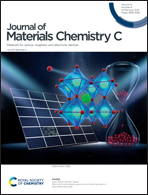Zinc ion functional doping for all-inorganic planar CsPbIBr2 perovskite solar cells with efficiency over 10.5%†
Abstract
The all-inorganic CsPbIBr2 perovskite solar cell (PSC) has received tremendous attention due to its favorable photoelectric properties and superior stability against moisture and heat attack. Nevertheless, the reported power conversion efficiency (PCE) of CsPbIBr2 PSC is still far from its counterparts, mainly because of the inferior film crystallization and morphology of the CsPbIBr2 light-absorbing layer, along with much trap defects and severe charge recombination. Herein, all-inorganic perovskite CsPbIBr2 is doped with ZnBr2 to improve crystallinity and morphology, optimize energy level alignment and enhance photovoltaic performance of PSC. Consequently, with the optimized concentration of Zn2+ (1%, at.), CsPb0.99Zn0.01IBr2-based PSC shows the highest PCE of 10.51%, which is 34% higher than that of CsPbIBr2-based PSCs (7.84%). Furthermore, the unencapsulated CsPb0.99Zn0.01IBr2-based device exhibits superior long-term stability in ambient atmosphere and against heat. This study provides a feasible strategy for preparing a high quality perovskite film and improving the photovoltaic performance and long-term stability of CsPbIBr2 PSCs, aiming at promoting the potential applications of CsPbIBr2-based PSCs.



 Please wait while we load your content...
Please wait while we load your content...